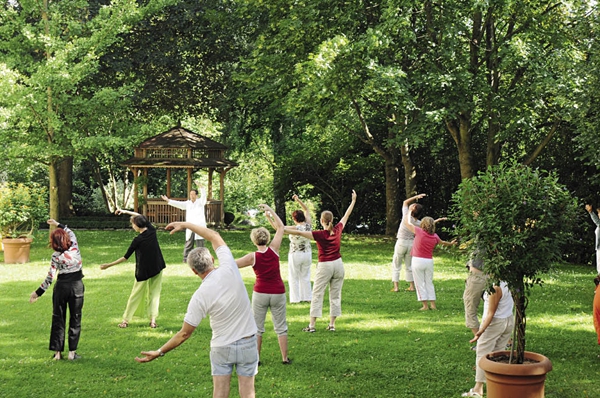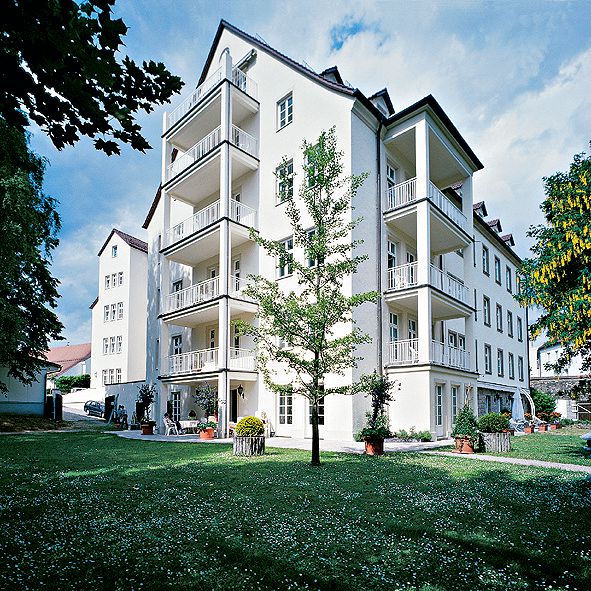By HELMUT MATT
By HELMUT MATT
AS one of the world’s ancient medical sciences, traditional Chinese medicine (TCM), with its distinctive concepts and methods, is believed to compensate for the deficiencies of Western medicine, and is gaining in popularity globally. So what is so special about TCM?
Ursula Wolf’s TCM Story
“TCM helped me when my doctors couldn’t find any effective way to treat my condition.” Such or similar comments are frequently heard from patients who have received TCM treatment. They have usually been plagued by a range of ailments, eventually resorting to the traditional methods of oriental medical sciences because conventional Western medicine neither relieves their pain nor offers a long-term cure.

Patients do qigong in the garden of the TCM clinic under the guidance of a TCM physician.
“The house in the town of Bad Kötzting in Bavaria actually looks nothing like a clinic, but more like a hotel,” said Ursula Wolf, who is 72 years old. Wolf knows this clinic very well; it was the first TCM clinic in Germany and where she turned when conventional Western medicine no longer helped her long-term struggle with pain.
More than 15 years ago Wolf suffered from protrusion of a lumbar intervertebral disc, causing extreme pain that extended to her toes. The doctor advised her to have surgery and wear a vest-like support to protect the spinal area. The surgery was successful. However, nine months later, the pain returned. She went back to her doctor, but all conventional therapies achieved no results. The pain was almost unbearable. Wolf had to rely on heavy dose of painkillers to get through each day.
In 1999, the Bavarian TV Station broadcast a program about a new hospital in the district of Cham, where the majority of its doctors came from China. The report said the clinic pursued a “new” concept by adopting a holistic approach to all diseases based on TCM.
Wolf immediately transferred to the TCM clinic. In the following three months, she was treated with methods such as acupuncture, tuina (a form of manipulative therapy), and qigong (a holistic system of coordinated body posture and movement, breathing, and meditation). The therapy was accompanied by an adjustment to diet and various herbal teas. After a period at the clinic, Wolf continued to practice qigong at home. After another three months the pain was gone and she remained in good physical condition for quite a long time.

72-year-old Ursula Wolf (right) recently bought a new bike to maintain her fitness.
Twelve years later, however, the familiar symptoms returned. Wolf went to her regular doctor, but again, Western medicine failed her. Besides the side effects caused by some of her medication, the high dosage of painkillers put a serious strain on her liver and other organs. Wolf, whose life quality was seriously affected, suffered severe depression. So she turned to TCM again at the same clinic as before. This time she completely recovered. Without the use of painkillers, the TCM doctors helped eliminate her pain. Today, Wolf leads a normal active life. Every day she goes swimming and recently bought a bike to maintain her fitness.
TCM: What Is That?
TCM and Western medicine are seemingly worlds apart as regards design and philosophy. Western medicine is characterized by a continuous exploration of diseases and their consequences. Doctors specialize in defined parts of the human body. Western medicine usually focuses on the treatment of diseases, but doesn’t adopt a holistic view towards the human body. In contrast, TCM focuses on the human body as a whole, rather than the disease. The body, inner world, spirit, and living environment are the elements that constitute a harmonious entirety. Diseases occur when this harmony is disturbed. In order to make a diagnosis with such a universal approach, TCM doctors need to pay particular attention to patients, make close observations, and analyze their history.
As the name indicates, traditional Chinese medicine is the accumulation of research results and knowledge on human health over millennia. It actually comprises the medical knowledge of different ethnic groups in China. Among them, the Han certainly enjoys the greatest influence, as it is the largest ethnic group with the longest history of written language. Taken as a whole, however, TCM more precisely refers to a shared experience of medical knowledge of all ethnic groups in China.
The history of TCM can be traced back to the Shang Dynasty (c.1600- 1028 BC). The unearthed inscriptions on bones and tortoise shells from over 3,000 years ago that recorded the medical system in embryo originated in the Yellow River catchment area. As early as about 1000 BC, physicians began to adopt the “four diagnostics” method: inspection, auscultation, inquiry, and palpation – and systematic use of herbal medicine. Acupuncture also originated in this period.
The first work on TCM is the Huangdi Neijing, also known as Yellow Emperor’s Inner Canon. This book expounds upon the interplay between human health and the change of the four seasons and the principle of yin and yang. Different from Western medicine that focuses on diseases, TCM was established on a holistic harmony between Heaven (nature) and man for thousands of years. The gist of the Huangdi Neijing is that human existence is like a microcosm in the infinite universe; therefore, people must achieve constant harmony with the law of nature and the changing seasons. Spring is the time for birth, summer for growing and flourishing, autumn for harvest, and winter for retention and storage. According to the Chinese traditional rules of energy, spring and summer belong to yang (the sun), while autumn and winter belong to yin (the shade). So it is important for people to absorb as much sunshine as possible in the first two seasons. As an old saying goes, there can be no life on earth without the sun; therefore, without yang energy humans cannot subsist at all. According to TCM theory, yang energy is conducive to recovery and transportation of qi (vital force), blood, and body fluids to enhance resistance to various potential diseases. According to the theories recorded in Huangdi Neijing, an important principle for health preservation is being abstinent and physically active, as well as keeping a regular sleep schedule. People should never over-eat, otherwise their digestive system will be overloaded, thus affecting their entire physical health. In addition, what is closely related to physical health is the balance of the inner world. Being upbeat, calm, and peaceful is the essential condition for overall human health.
Since its inception, TCM has undergone constant and continuous development. With the dawn of the Confucian era, magical elements, belief in spirits and gods, and actions such as offering sacrifices had given way to the system of TCM and its concept. In this context, the yin-yang doctrine and the theory of the five elements in Huangdi Neijing were not only the foundation for the newly-established medicine system, but also an expression of Confucian sociopolitical ideas and theory. The five elements refer to metal, wood, water, fire, and earth. Their interaction features mutual generation and mutual effectiveness if placed in different orders. In classical Chinese theory, the laws of nature and environment derive from the transformation of the five elements.
Alongside the accumulation of knowledge on herbs and medicine, more books on TCM were written in the following centuries. For example, the Shanghan Lun, known in English as Treatise on Febrile Diseases, is a canonical work on the treatment of febrile diseases.
TCM’s Path to Modernity
In the 19th and early 20th centuries, the existence of TCM was greatly suppressed and often replaced by Western medicine. In the second half of the 19th century, imperialist powers colonized part of China’s territory and introduced Western science and technology, as well as Western philosophy. Chinese people would often choose Western medical treatment over TCM when they fell ill. TCM was increasingly pushed out and some people even proposed to ban its practice.
A crucial turning point came with the founding of the People’s Republic of China in 1949. Chairman Mao Zedong recognized the advantages of TCM – it could provide effective medical care for China’s huge population, especially in rural areas, bearing in mind the limited funds at the time. He said: “Chinese medicine and pharmacology are a great treasure house and efforts should be made to explore them and raise them to a higher level.” Chinese medicine and its therapeutic practices were reborn hereafter and evolved into a scientific system we understand today.

The house in the town of Bad Kötzting in Bavaria, South Germany, actually looks nothing like a clinic, but rather like a hotel.
The Chinese government chooses TCM as the preferred health care for the people, and develops it through encouraging research and innovation. Since the mid-1980s, when both Western medicine and TCM made huge advances, efforts have been made to build and develop a medical system that features a combination of TCM and Western medicine. In fact, much headway has been made in this regard. Today, TCM in China is linked with Western medicine to a large extent. Students who majored in TCM are now also taught Western medicine. All licensed TCM physicians can also prescribe Western medicines.
The World Discovers TCM
Although TCM has a history of a few thousand years, it became known in Western culture only a few decades ago. Some European scholars first got to know about TCM in the 17th and 18th centuries; however, their knowledge of the specific practices was soon lost. By the 1950s, the Western world again became interested in this complex field. TCM gained real attention and emerged in the Western world in 1971 when James Reston, an American journalist, wrote a report on how his pain following surgery to remove his appendix had been treated by acupuncture. He published the article in the New York Times.
Today, the international community recognizes the advantages of TCM. According to WHO statistics, TCM has been practiced in over 170 countries and regions around the world, and acupuncture has been used as a healing method in more than 100 countries. There are over 80,000 TCM clinics, with some 300,000 physicians. More than 80 countries have signed cooperation agreements with China in the field of TCM.
Last year, Tu Youyou, a Chinese TCM researcher, won the Nobel Prize in physiology/medicine, an achievement that has injected new dynamism into the global development of TCM. The Norwegian Nobel Committee awarded the prize to Tu for her contribution to the discovery of artemisinin, which is used to treat malaria.
Tu was born in 1930 in Ningbo City in eastern China’s Zhejiang Province. She studied at the Department of Pharmaceutical Sciences at Peking University Health Science Center from 1951 to 1955. After graduation, she worked at the China Academy of Chinese Medical Sciences, where she was responsible for a project assigned by the Chinese government to conduct research into medicines for the treatment of malaria in 1969. After studying more than 200 herbal medicines and countless TCM recipes, the research team under her leadership finally extracted a substance, artemisinin, in 1972, which can effectively treat malaria.
In an interview Tu Youyou said that for her what was most important was not winning the Nobel Prize, but the achievement that her team made. It has given new life to TCM research and encouraged TCM researchers to achieve more results and breakthroughs. This is certainly something to look forward to, and what we now know is that Tu Youyou has made an invaluable contribution to humanity, especially people in third world countries.